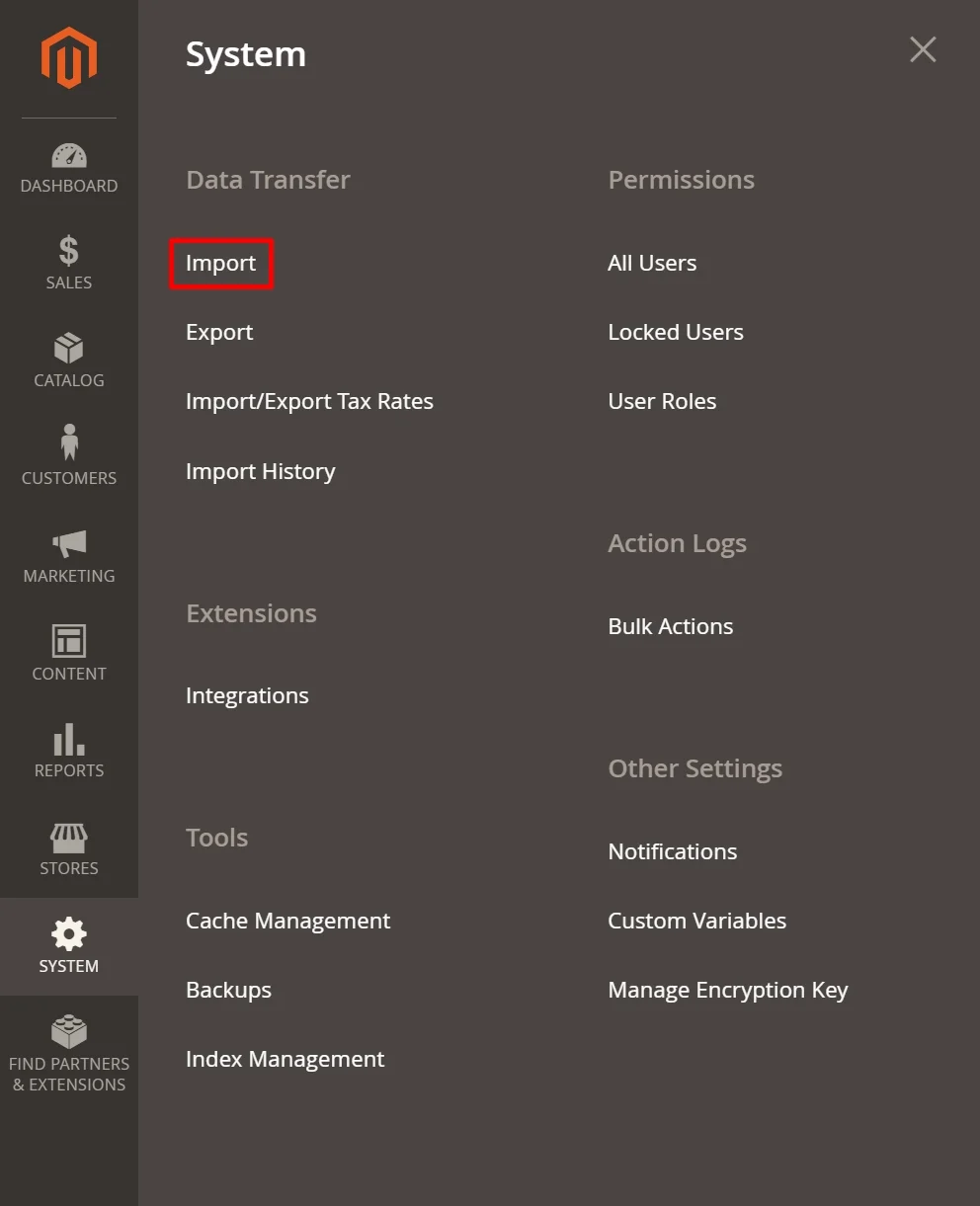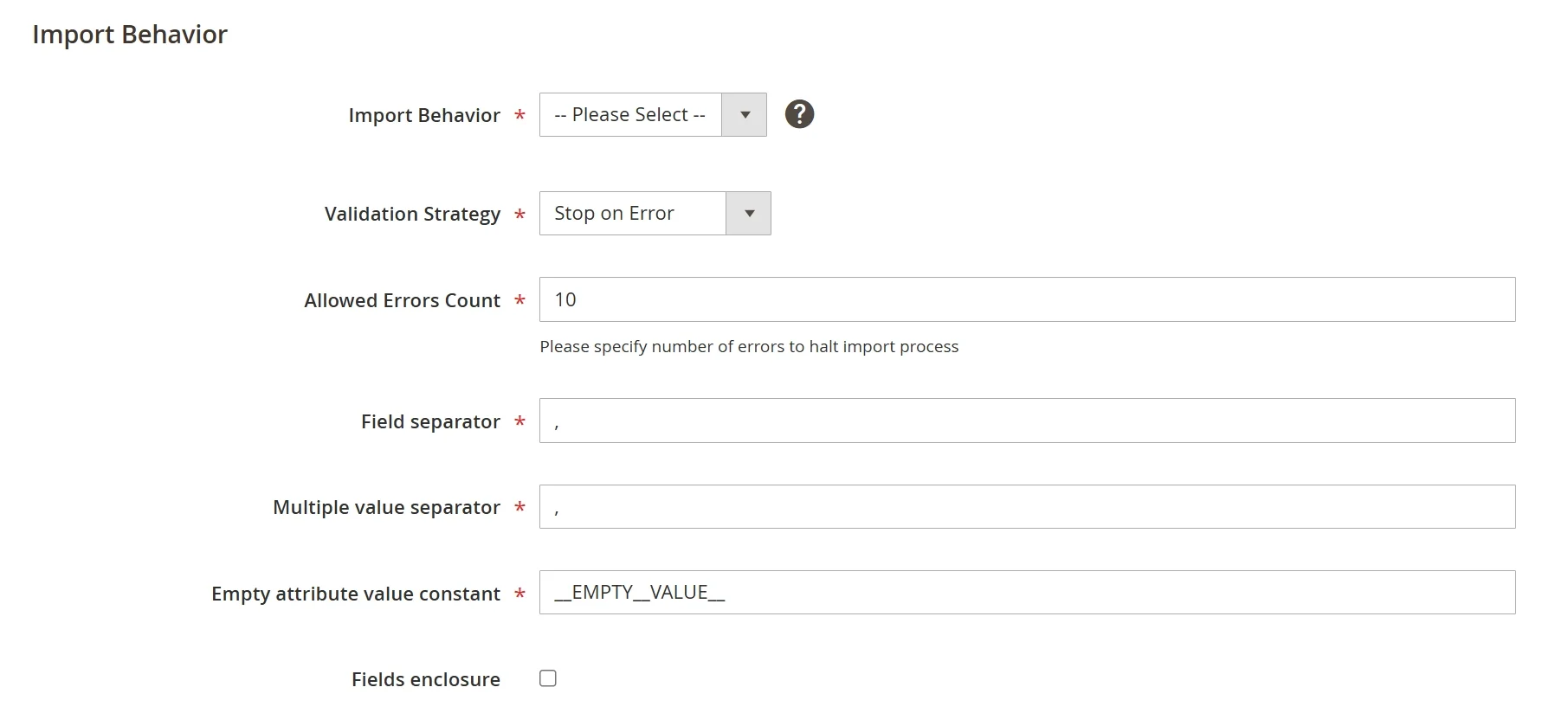Managing product data can be time-consuming, especially if you run a large Magento store. That’s where Magento data feed import comes in, allowing you to upload a large amount of product information quickly and saving you hours of manual work.
In this guide, we'll explain how Magento data feed import works by exploring:
- Definition, types, and required attributes in Magento data feed
- How to import and export data feed in Magento
- Best extensions to import Magento data feed automatically
- Common problems and how to solve them
- Best practices for a successful data feed import
Without further ado, let's get right in!
Magento Data Feed Import – All You Need to Know
Before you start using Magento data feed import, it’s important to understand what it is and how it works. In this section, we’ll cover the basics, the types of data feed imports you can use, and the required attributes you should prepare for a smooth process.
What is a data feed in Magento
A data feed in Magento is a structured file that contains product information such as SKU, name, price, description, and images. This file usually comes in formats like CSV, XML, or TXT, making it easy to share and process.
The main purpose of a data feed is to let you upload, update, or sync large amounts of product data in one go. Instead of editing each item manually, you can manage hundreds or even thousands of products more efficiently. You can also use a Magento data feed to connect your store with external platforms like Google Shopping, Amazon, or eBay. By doing this, your product information stays accurate and consistent across all channels.
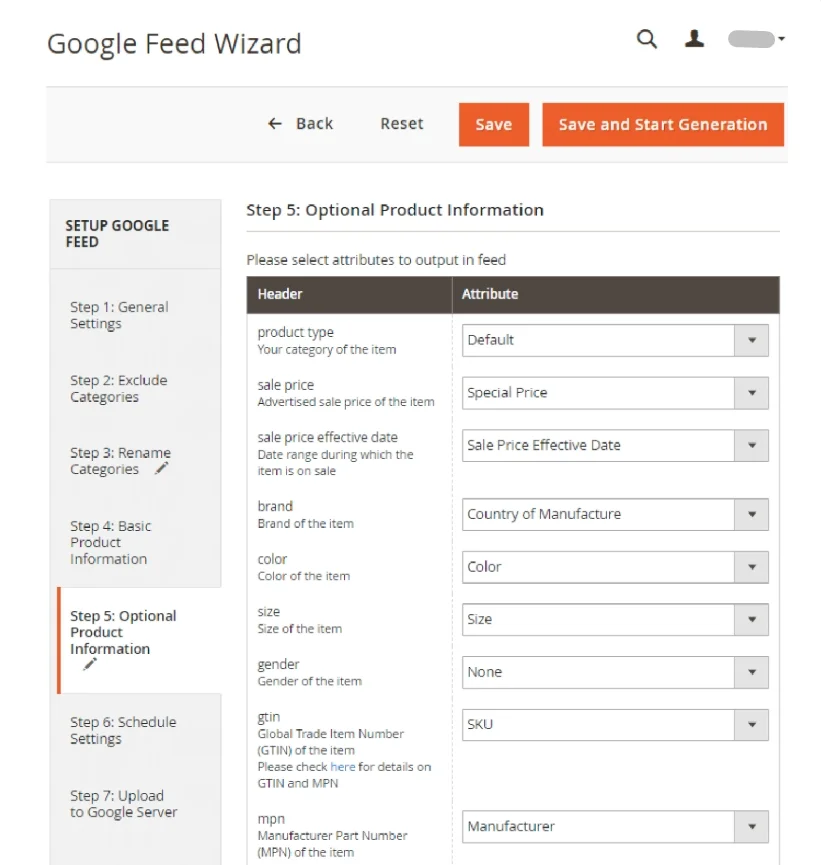
Types of Magento data feed import
There are different ways to handle Magento data feed import, and each method suits specific needs. The table below will list out the most common ways to perform this action.
Type | Description | Use case |
Manual upload | Uploads a CSV or XML file directly through the Magento admin panel. | Best for small catalogs or one-time updates. |
FTP/SFTP import | Imports data automatically from a server connection at scheduled intervals. | Useful for recurring imports from suppliers or partners. |
API-based import | Uses Magento or third-party APIs to push and pull data. | Ideal for large stores needing real-time synchronization. |
Extension-based import | Relies on Magento extensions to simplify and automate the import process. | Perfect for non-technical users who want easy setup and ongoing updates. |
Magento data feed attributes
When preparing a file for Magento data feed import, it's essential to understand what attributes are included. Fortunately, Magento allows users to import only the data with changes, eliminating the lengthy process of filling in the excessive columns. In this section, let's take a look at the recommended attributes that are often included in a data feed file. For a full list of Magento product attributes, please check out this guide by Adobe Commerce.
Attribute | Description |
sku(Required) | The unique identifier for each product, used to track inventory. An SKU should not be longer than 64 characters. |
product_type | The type of product, could be set as either: Simple, Grouped, Configurable, Virtual, Bundle. |
categories | The category that is assigned to the product. |
name | The product name appears in all product listings, and is the name that customers use to identify the product. |
description | The product description provides detailed information about the product, and might include simple HTML tags. |
short_description | The use of the short product description depends on the theme. It might appear in product listings and is sometimes used in RSS feed listings sent to shopping sites. |
tax_class_name | The name of the tax class that is associated with this product. |
product_online | Determines if the product is available for sale in the store. |
price | The price that the product is offered for sale in your store. |
meta_title | The meta title appears in the title bar and tab of the browser and search results lists. Must be fewer than 70 characters. |
meta_keywords | Meta keywords are visible only to search engines, and are ignored by some search engines. |
meta_description | Meta descriptions provide a brief overview of the product for search results listings. |
How to Perform Magento Data Feed Import
Importing Magento products through a data feed is quite straightforward once you have the right file prepared. Magento allows you to manage this directly from the admin panel, making the process simple and accessible. Here’s a quick step-by-step guide to perform a Magento data feed import:
- Step 1. From your Magento admin panel, navigate to “System” > “Data Transfer” > “Import”.
- Step 2. In the Entity Type section, select “Product”.
- Step 3. Then, choose the “Import Behavior” depending on the action you want to perform:
- Add/Update: Add new products and update existing ones, except for SKUs.
- Replace: Overwrite the existing product data entirely with the new data.
- Delete: Removes products that match entries in the CSV.
- Step 4. Upload your CSV file and click Check Data to validate the structure.
- Step 5. If no errors appear, click Import to complete the process.
For more detailed instructions, please check out our article on Magento 2 import products guidelines. Or, if you want to automate and scale the process, you may need to consider using extensions or third-party tools, which we will discuss in the next section.
Best Extensions to Import Magento Data Feed Automatically
While the built-in import tool is helpful, it can be limited for larger catalogs or recurring updates. To save time and reduce errors, many store owners turn to extensions that automate the process. These tools make Magento data feed import faster, more flexible, and easier to manage.
In this section, we’ll look at some of the best extensions available, along with their key features and pricing.
#1 LitCommerce Product Feed Management
LitCommerce is a powerful multichannel selling tool that helps Magento users create and manage product feeds with ease. Instead of manually uploading files or making repeated changes in the backend, you can rely on LitCommerce to handle the heavy lifting.
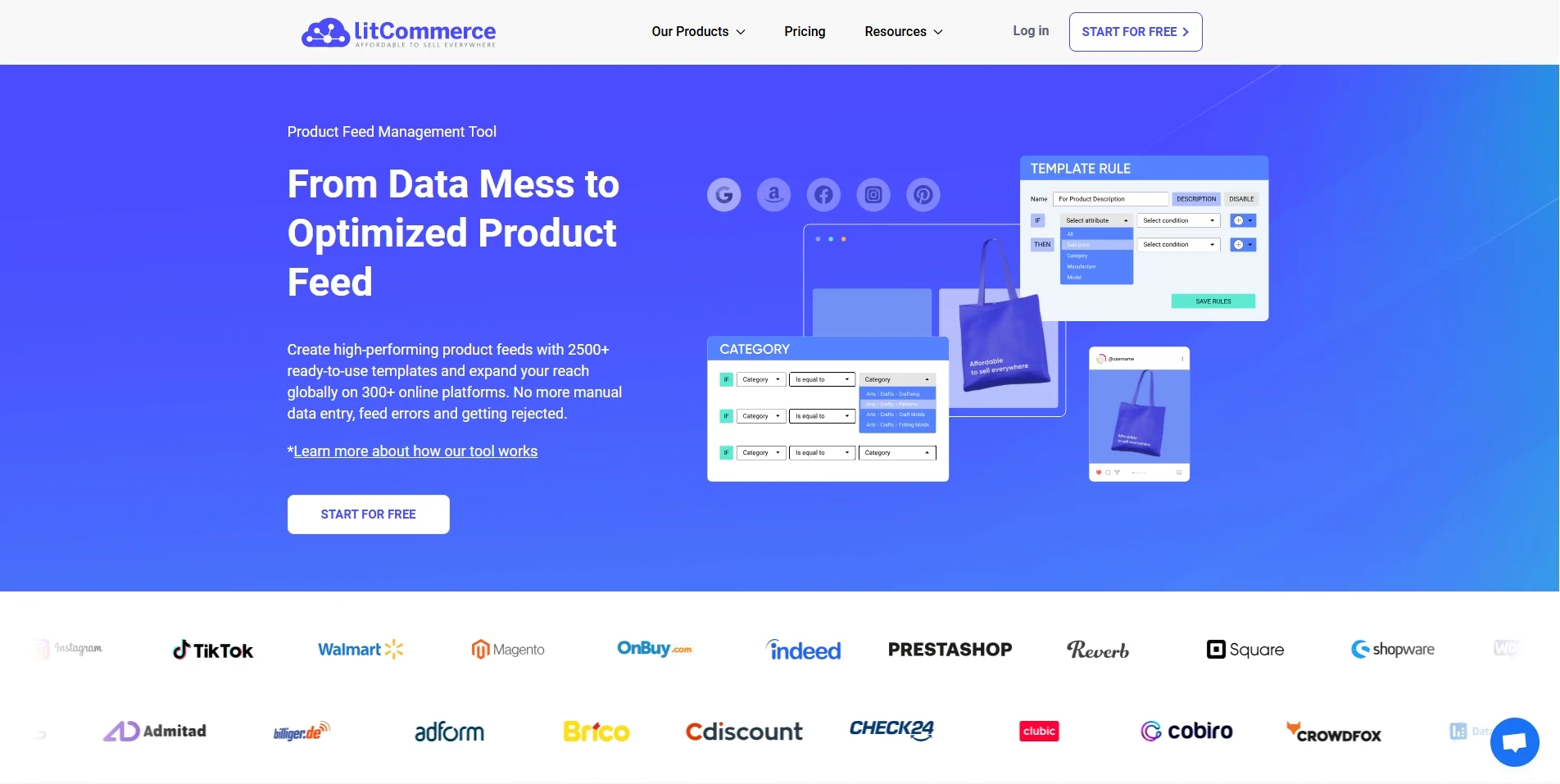
The tool is designed to connect your Magento store with popular marketplaces such as Amazon, eBay, Etsy, and Google Shopping, ensuring your products reach a wider audience. With automated syncing and customizable rules, LitCommerce makes Magento data feed import and ongoing product management much more efficient.
Key features that the LitCommerce Product Feed Management tool offers:
- Create and customize product feeds tailored to each marketplace.
- Bulk update product information, pricing, and inventory in just a few clicks.
- Real-time synchronization of stock levels across all connected channels.
- User-friendly dashboard with no technical skills required.
- Advanced mapping rules to ensure accurate attribute matching.
Pricing: Custom pricing based on the number of feeds and SKUs, with a free plan available.
#2 DataFeedWatch
DataFeedWatch is a well-known feed management solution that helps Magento store owners optimize and distribute product data to hundreds of shopping channels. With its easy-to-use interface, you can take control of how your product information is structured and displayed on platforms like Google Shopping, Facebook, and Amazon.
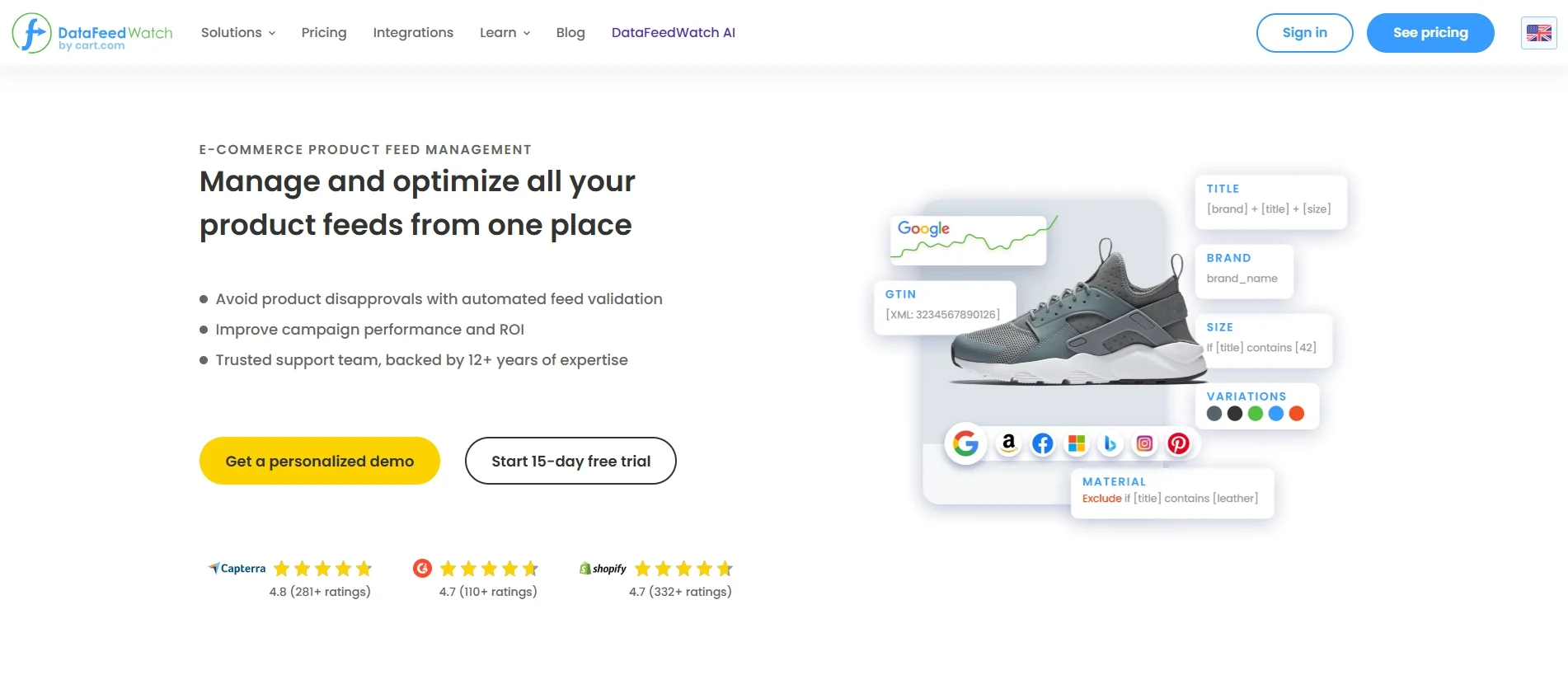
By streamlining the Magento data feed import process, DataFeedWatch reduces errors and ensures your listings are always accurate and up to date.
Key features that Data Feed Watch offers:
- Create, edit, and optimize product feeds for over 2,000 global channels.
- Apply advanced rules to clean and map product data automatically.
- Monitor feed performance and improve campaigns with detailed analytics.
- Support for multiple currencies and languages to reach international customers.
- Flexible scheduling to keep product data refreshed across all platforms.
Pricing: Starting from $64 to $196 per month, with a custom plan available.
#3 Channable
Channable is an all-in-one feed management and PPC automation tool that integrates smoothly with Magento. It gives you full control over how your product data is structured and distributed, allowing you to create, optimize, and send feeds to thousands of channels such as Google Shopping, Facebook, Instagram, Amazon, and many more.

By simplifying the Magento data feed import process, Channable ensures your product information is always accurate and up to date across every platform. At the same time, its advanced filtering and rule-based system lets you adjust product details for specific channels, so each feed is optimized for performance.
Key features that Channable offers:
- Generate and customize product feeds for over 2,500 global marketplaces and advertising platforms.
- Rule-based system to filter, enrich, and optimize data feeds with ease.
- Built-in PPC campaign automation for Google Ads and Microsoft Advertising.
- Real-time inventory and price synchronization across all connected channels.
- Performance tracking and analytics to fine-tune your campaigns.
Pricing: Custom pricing based on the number of your products and variants.
#4 Mageplaza Product Feed for Magento 2
Mageplaza Product Feed is a Magento-specific extension designed to help store owners generate and manage product feeds with minimal effort. It supports a wide range of templates and integrations, making it easy to distribute your catalog to major shopping channels like Google Shopping, Facebook, Bing, and more.
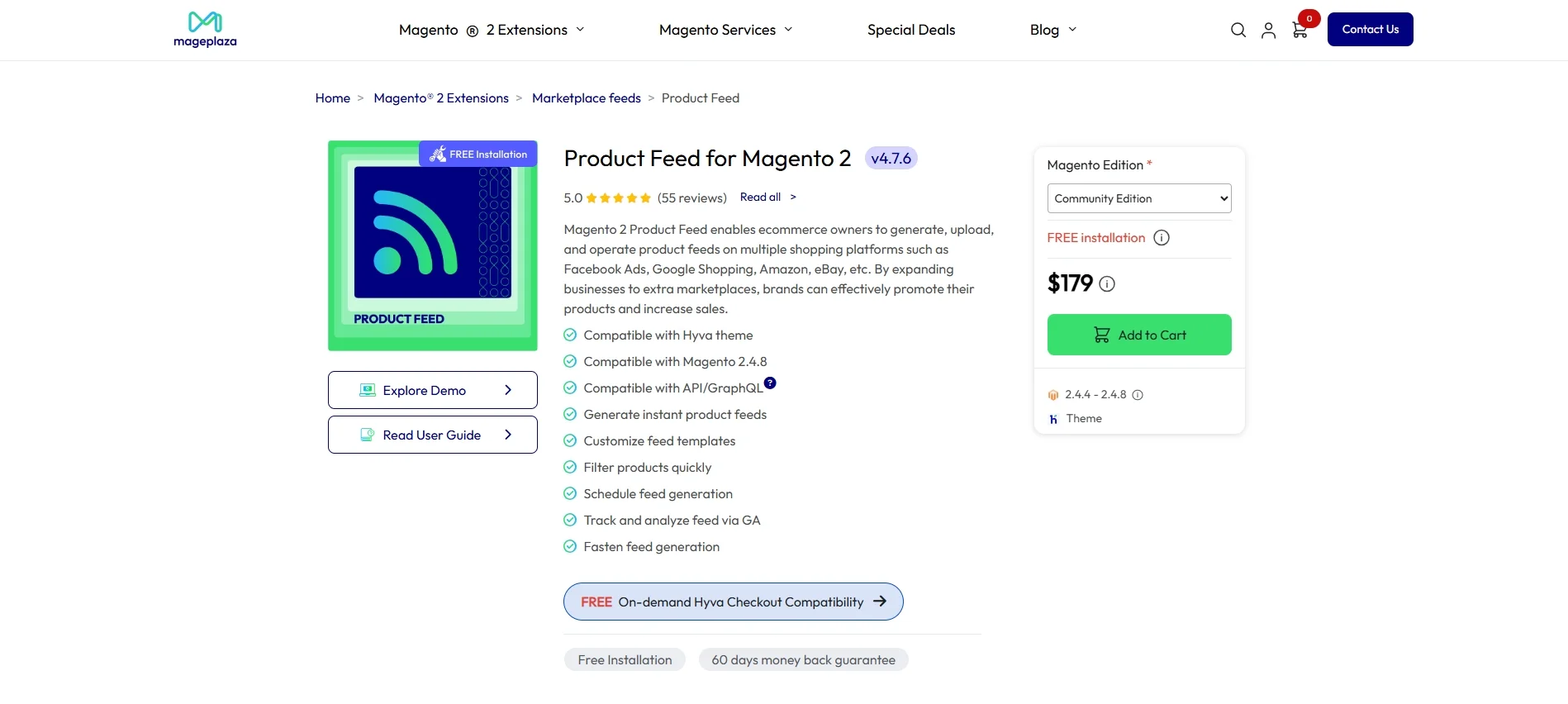
With its automation features, this tool streamlines Magento data feed import and ensures your product information is always accurate and up to date.
Key features that Mageplaza Product Feed for Magento 2 offers:
- Ready-made feed templates for popular channels such as Google Shopping, Facebook, and Bing.
- Customizable feed rules to match your unique product attributes.
- Scheduled feed generation and updates via cron jobs.
- Support for multiple file formats, including CSV, TXT, and XML.
- Detailed reports and logs to monitor the status of your feed exports.
Pricing: $179.
Common Problems and How to Solve Them
Even though Magento data feed import is a powerful feature, it often comes with challenges that can interrupt your workflow. Many issues arise from formatting errors, missing attributes, or system limitations. The good news is that most of these problems have straightforward solutions, and the table below highlights common problems and how you can solve them.
Problem | Solution |
File format not accepted | Ensure the file is saved as CSV or XML and follows Magento’s structure. |
Missing required attributes | Double-check that all required fields are included. |
Import validation errors | Use Magento’s Check Data option before importing to identify the error. |
Duplicate product data | Select the correct Import Behavior (Add/Update, Replace, or Delete). |
Incorrect character encoding | Save the file in UTF-8 format to avoid special character errors. |
Timeout or server resource issues | Split large files into smaller batches or increase PHP/server limits. |
Best Practices to Import Magento Data Feed Successfully
Carrying out a Magento data feed import is more than just uploading a CSV file. To make the process efficient and error-free, you need to follow certain practices that ensure your data remains accurate, complete, and consistent across your store and sales channels. A well-prepared approach not only saves time but also reduces the risk of failed imports and missing product details.
Here are some best practices you should keep in mind for a successful Magento data feed import:
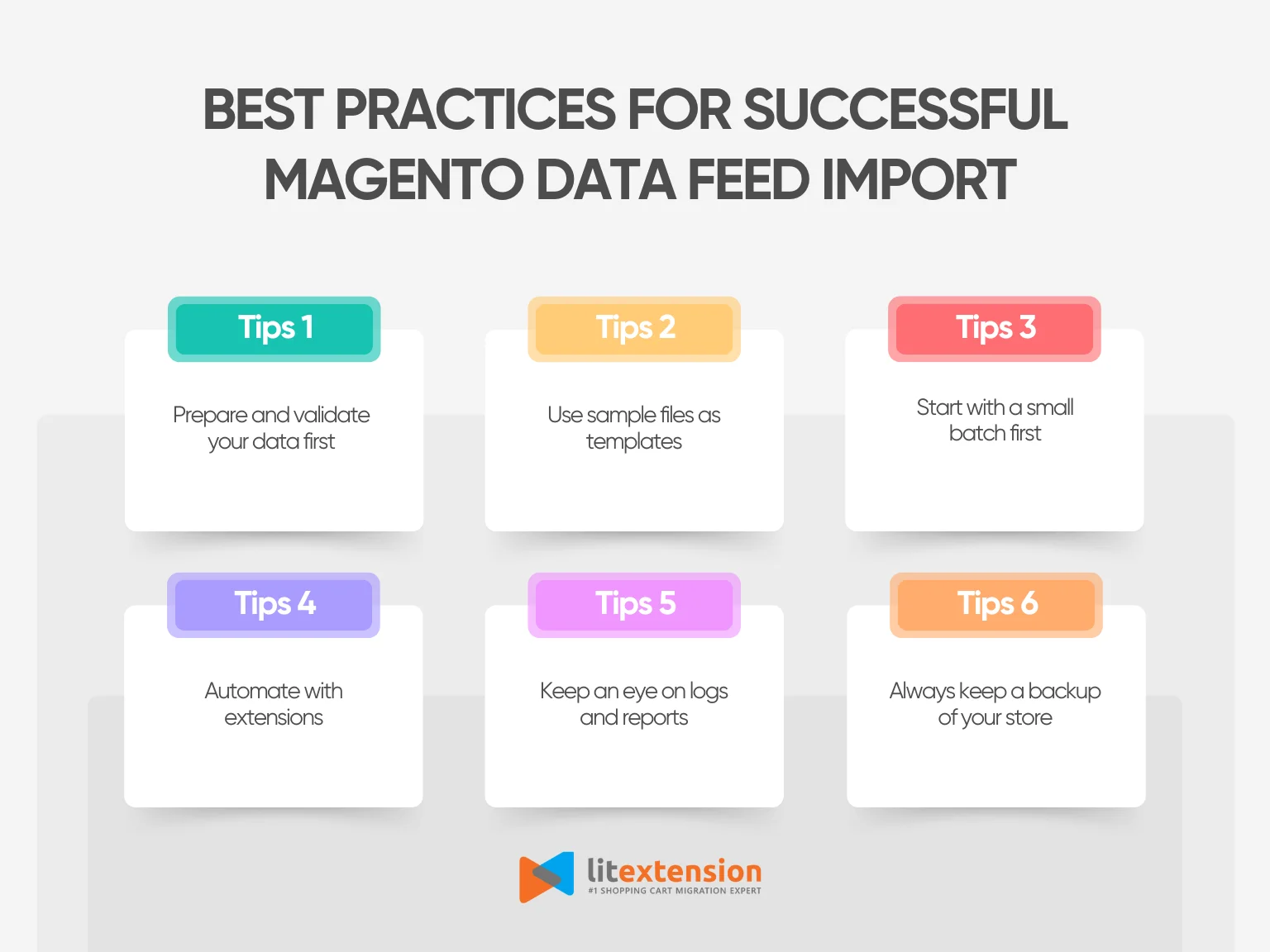
- Prepare and validate your data first: Clean your file, remove duplicates, and ensure all required attributes like SKU, name, and price are included.
- Use sample files as templates: Export a sample product file from Magento and use it as a reference for your data structure.
- Start with a small batch: Test the import with a limited number of products before processing the full catalog.
- Automate with extensions: Set up scheduled imports to save time and reduce repetitive manual tasks.
- Monitor logs and reports: Review Magento’s import history for errors or warnings and resolve them before running the next import.
- Keep a backup of your store: Always back up your database and files before large imports to protect your data.
By following these steps, you can make Magento data feed import more reliable, scalable, and less prone to costly mistakes.
Magento Data Feed Import – FAQs
How to import Magento data feed?
Here’s a quick step-by-step guide to perform a Magento data feed import:
1. Go to System > Data Transfer > Import in your Magento admin panel.
2. Select Products as the Entity Type you want to import.
3. Choose Add/Update or another import behavior that matches your goal.
4. Upload your CSV file and click Check Data to validate the structure.
5. If no errors appear, click Import to complete the process.
For larger catalogs or recurring updates, you can also automate the process using extensions that schedule and manage imports automatically.
What is included in a Magento data feed file?
A Magento data feed file typically includes key product details such as SKU, name, price, description, attribute set code, product type, categories, visibility, and status. Depending on your needs, you can also include optional attributes like images, stock quantity, or weight.
What data feed format does Magento support?
Magento primarily supports the CSV format for data feed import and export. However, with the help of extensions or third-party tools, you can also work with formats like XML, TXT, or JSON for added flexibility.
Final Words
To conclude, handling Magento data feed import the right way can save you a significant amount of time and keep your store data accurate across all channels. From understanding required attributes to using automation tools, each step helps you manage products more efficiently and reduce errors.
Last but not least, for a deeper dive into this platform, please check out other Magento articles on LitExtension to get more expert insights and guidelines.
